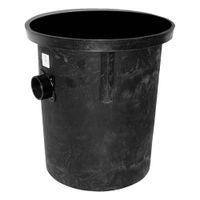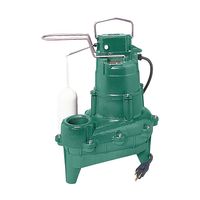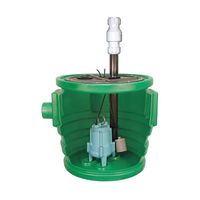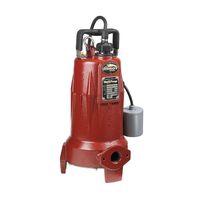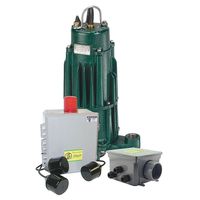Call +(254) 703 030 000 / 751 483 999 / 721 704 777
- Home
- Pumps
- Sump Sewage Utility Pumps
- Sewage Effluent Pumps
- Sewage Pumps Systems Basins
Sewage Pumps, Systems & Basins
Sewage pumps, systems, and basins transfer wastewater containing solids through a drain system. These sewage pump systems come with items for sewage pump installation including basins, pipe, pumps, and often alarms, check valves, and switches. Sewage ejector pumps move sewage where a gravity system .....Read More
Frequently Asked Questions
What is the difference between a sewage ejector pump and a sewage grinder pump?
A sewage ejector pump and a sewage grinder pump are both used to move wastewater from lower to higher elevations, but they serve different purposes and operate differently.
A sewage ejector pump is designed to move wastewater from a lower elevation, such as a basement, to a higher elevation where it can enter the main sewer line. It is typically used in residential applications where the plumbing fixtures are located below the level of the main sewer line. The ejector pump can handle solid waste, but it is primarily designed to move liquid waste. It uses a centrifugal pump mechanism to push the waste upward. Ejector pumps are generally less expensive and are suitable for typical household waste.
On the other hand, a sewage grinder pump is used in situations where the waste needs to be broken down into smaller particles before being pumped. It is equipped with a grinding mechanism that shreds solid waste into a slurry, making it easier to pump through smaller diameter pipes. Grinder pumps are often used in commercial or industrial settings, or in residential areas where the waste needs to be transported over long distances or through small pipes. They are more powerful and can handle tougher waste materials, but they are also more expensive and require more maintenance.
In summary, the main difference lies in their function and application: ejector pumps are used for moving waste to a higher elevation, while grinder pumps are used for breaking down waste into smaller particles for easier transport.
How do I install a sewage pump system?
1. **Plan and Design**: Determine the location for the sewage pump system, ensuring it is below the lowest drain in the house. Obtain necessary permits and check local codes.
2. **Excavation**: Dig a pit for the basin, ensuring it is deep enough for the basin to sit flush with the floor. The pit should be wide enough to allow for backfilling.
3. **Install the Basin**: Place the sewage basin in the pit. Ensure it is level and stable. Backfill around the basin with gravel or sand to secure it in place.
4. **Plumbing Connections**: Connect the inlet pipe from the house to the basin. Ensure it is properly sealed to prevent leaks. Install a vent pipe to prevent airlocks and allow gases to escape.
5. **Install the Pump**: Place the sewage pump inside the basin. Connect the discharge pipe to the pump, ensuring it is securely fastened. The discharge pipe should lead to the main sewer line or septic tank.
6. **Check Valve and Union**: Install a check valve on the discharge pipe to prevent backflow. Include a union fitting for easy pump removal and maintenance.
7. **Electrical Connections**: Connect the pump to a dedicated GFCI-protected electrical outlet. Ensure all electrical work complies with local codes and is performed by a qualified electrician if necessary.
8. **Test the System**: Fill the basin with water to test the pump. Ensure it activates and discharges water properly. Check for leaks and ensure the check valve functions correctly.
9. **Cover and Seal**: Secure the basin cover, ensuring it is airtight to prevent odors. Seal any gaps around the basin with silicone or appropriate sealant.
10. **Final Inspection**: Have the system inspected by local authorities if required to ensure compliance with regulations.
What size sewage pump do I need for my home?
To determine the appropriate size sewage pump for your home, consider the following factors:
1. **Flow Rate**: Calculate the total flow rate required by adding the flow rates of all fixtures that will discharge into the sewage system. A typical household may require a pump with a flow rate of 5 to 10 gallons per minute (GPM).
2. **Total Dynamic Head (TDH)**: Determine the vertical lift (static head) from the pump to the highest point in the discharge line, and add the friction loss in the pipes. This will give you the TDH, which is crucial for selecting a pump that can handle the required lift.
3. **Pump Type**: Choose between a submersible sewage pump and a pedestal pump. Submersible pumps are more common for residential use due to their efficiency and quiet operation.
4. **Horsepower (HP)**: Based on the flow rate and TDH, select a pump with adequate horsepower. For most residential applications, a pump with 0.5 to 1 HP is sufficient.
5. **Solids Handling**: Ensure the pump can handle the size of solids expected in the sewage. A pump with a 2-inch or larger discharge is typically recommended for residential use.
6. **Power Supply**: Verify that your electrical system can support the pump's voltage and amperage requirements.
7. **Reliability and Durability**: Choose a pump made from durable materials like cast iron or stainless steel for longevity and reliability.
8. **Backup System**: Consider a backup pump or battery system to ensure operation during power outages.
By evaluating these factors, you can select a sewage pump that meets your home's specific needs.
How often should a sewage pump be serviced or maintained?
A sewage pump should be serviced or maintained at least once a year. Regular maintenance ensures the pump operates efficiently and prevents potential failures that could lead to costly repairs or replacements. During the annual service, a professional should inspect the pump for any signs of wear and tear, check the electrical connections, and ensure that the float switch is functioning correctly. The pump and its components should be cleaned to remove any debris or buildup that could impede performance.
In addition to the annual service, it's advisable to conduct periodic checks every few months. These checks can include visually inspecting the pump for any obvious issues, listening for unusual noises during operation, and ensuring that the pump is cycling on and off correctly. If the pump is used more frequently or in a high-demand environment, more frequent maintenance may be necessary.
Homeowners should also be aware of any changes in the pump's performance, such as longer run times or unusual noises, as these can indicate potential problems. Addressing these issues promptly can prevent more significant problems from developing.
In summary, while an annual professional service is recommended, regular checks and prompt attention to any performance changes can help maintain the sewage pump's efficiency and longevity.
What are the signs that a sewage pump is failing?
1. **Unusual Noises**: Grinding, rattling, or whining sounds may indicate mechanical issues or debris in the pump.
2. **Frequent Clogging**: Regular blockages can suggest the pump is not effectively moving waste.
3. **Foul Odors**: Persistent sewage smells around the pump area can signal leaks or inefficiencies.
4. **Increased Energy Bills**: A failing pump may work harder, consuming more electricity.
5. **Slow Drainage**: If water drains slowly from sinks, toilets, or showers, the pump might be underperforming.
6. **Pump Not Turning On/Off**: Electrical or float switch issues can prevent the pump from operating correctly.
7. **Visible Leaks**: Water or sewage around the pump indicates possible seal or pipe failures.
8. **Frequent Cycling**: The pump turning on and off more than usual can point to a malfunctioning float switch or pressure sensor.
9. **Vibrations or Shaking**: Excessive movement during operation can be a sign of imbalance or mechanical failure.
10. **Age of the Pump**: Older pumps are more prone to failure due to wear and tear.
11. **Tripped Circuit Breaker**: Electrical issues can cause the pump to trip the breaker frequently.
12. **Corrosion or Rust**: Visible deterioration on the pump or its components can affect performance.
13. **Water Backups**: Sewage backing up into the home is a critical sign of pump failure.
14. **Alarm Activation**: Many systems have alarms that sound when the pump is not functioning properly.
15. **Reduced Pumping Efficiency**: If the pump takes longer to clear the basin, it may be losing efficiency.
Can sewage pumps handle hot water and chemicals?
Sewage pumps are generally designed to handle wastewater, which includes a mix of water, human waste, and other organic materials. However, their ability to handle hot water and chemicals depends on the specific design and materials used in the pump.
1. **Hot Water**: Most standard sewage pumps can handle water temperatures up to around 140°F (60°C). Exceeding this temperature can damage the pump's components, such as seals and impellers, leading to reduced efficiency or failure. For applications involving higher temperatures, specialized pumps made from heat-resistant materials are required.
2. **Chemicals**: Sewage pumps are typically constructed from materials like cast iron, stainless steel, or thermoplastics, which can resist mild chemicals found in household wastewater. However, exposure to strong acids, bases, or industrial chemicals can corrode or degrade these materials. For environments with high chemical concentrations, pumps made from corrosion-resistant materials like stainless steel or those with special coatings are necessary.
In summary, while standard sewage pumps can handle typical household wastewater, including some hot water and mild chemicals, they are not suitable for high temperatures or strong chemicals without risking damage. For such conditions, specialized pumps designed for heat and chemical resistance should be used.
How do I troubleshoot common sewage pump problems?
1. **Power Supply Check**: Ensure the pump is receiving power. Check the circuit breaker and fuse box for tripped breakers or blown fuses. Reset or replace as necessary.
2. **Float Switch Inspection**: Examine the float switch for obstructions or damage. Ensure it moves freely and is not stuck, as this controls the pump's operation.
3. **Clogged Impeller**: Turn off the power and inspect the impeller for debris or blockages. Clean it thoroughly to ensure smooth operation.
4. **Pump Overheating**: Check for overheating by feeling the pump casing. Overheating can be caused by continuous operation or a blocked discharge line. Allow the pump to cool and clear any blockages.
5. **Discharge Line Blockage**: Inspect the discharge line for clogs or obstructions. Clear any debris to ensure proper flow.
6. **Check Valve Malfunction**: Ensure the check valve is functioning correctly. A faulty valve can cause backflow and prevent the pump from operating efficiently.
7. **Air Lock**: Release any trapped air in the pump by manually priming it or adjusting the discharge line to eliminate air pockets.
8. **Seal and Gasket Inspection**: Examine seals and gaskets for wear or damage. Replace if necessary to prevent leaks.
9. **Motor Issues**: Listen for unusual noises indicating motor problems. If the motor hums but doesn’t run, it may need professional repair or replacement.
10. **Regular Maintenance**: Schedule regular maintenance checks to clean and inspect all components, ensuring longevity and efficiency.
11. **Professional Assistance**: If problems persist, consult a professional plumber or technician for a thorough inspection and repair.
